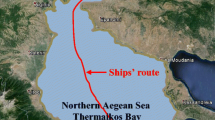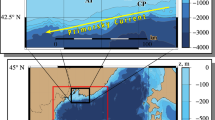Modeling was done of a hypothetical accidental fuel spill in the water area of a projected marina at Sochi. In order to calculate the spread of a fuel patch into the port, the SELFE three-dimensional hydrodynamic model and the OILTOX model of the spread of oil and oil products were used. The three-dimensional flow fields before and after port reconstruction were calculated for three scenarios of hydro-meteorological conditions.
Similar content being viewed by others
References
Y.-L. Zhang and A. M. Baptista A. M. “SELFE. A semi-implicit Eulerian-Lagrangian finite-element model for cross-scale ocean circulation,” Ocean Model., 21(3 – 4), 71 – 96 (2008).
I. A. Brovchenko, V. S. Maderich, and E. V. Terletskaya,. “Numerical modeling of the three-dimensional structure of currents in the region of deepsea canyons of the eastern littoral of the Black Sea,” Int. J. Comput. Civil Struct. Eng., 7(2), 47 – 53 (2011).
X. Bertin, A. Oliveira, and A. B. Fortunato, “Simulating morphodynamics with unstructured grids: Description and validation of a modeling system for coastal applications,” Ocean Model., 28(1 – 3), 75 – 87 (2009).
M. Burla, A. M. Baptista, Y. Zhang, and S. Frolov, “Seasonal and interannual variability of the Columbia River plume: Aperspective enabled by multiyear simulation databases,” J. Geo-Phys. Res., 115, C00B16 (2010).
A. Roland, Y. B. Zhang, H. V. Wang, Y. Meng, Y. S. Teng, V. Maderich, I. Brovchenko, M. Dutour-Sikiric, and U. Zanke, “A fully coupled 3D wave-current interaction model on unstructured grids,” J. Geophys. Res., (2012).
I. A. Brovchenko and V. S. Maderich, “A numerical Lagrangian method of modeling the spread of surface oil spills,” Prikl. Gidromekh., 4(76), No. 4, 23 – 31 (2002).
I. A. Brovchenko, “Application of particle methods in problems with non-structured grids,” Mat. Machines Syst., No. 3, 111 – 115 (2010).
I. A. Brovchenko, “A model of the formation of the pattern of oil drops in the near-surface layer of the ocean,” Prikl. Gidromekh., 6(78), No. 2, 20 – 26 (2004).
V. M. Zhurbas, “Basic mechanisms of the spread of oil in the sea,” Itogi Nauki Tekh. Mekh. Zhidk. Gaza, 12, 144 – 160 (1978).
V. I. Nikishov, “One method of spreading a film of a surfactant,” Inzh.-Fiz. Zh., 46(6), 958 – 962 (1983).
V. Maderich and I. Brovchenko, “Oil dispersion by breaking waves and currents,” Sea Technol., 46(4), 17 – 22 (2005).
V. Maderich, I. Brovchenko, and K. T. Jung, “Oil spreading from continuous source on rotating Earth,” J. Environm. Fluid Mech., 12(4), 361 – 378 (2012).
I. Brovchenko, A. Kuschan, V. Maderich, M. Shliakhtun, S. Yuschenko, and M. Zheleznyak, “The modeling system for simulation of the oil spills in the Black Sea,” in: Proc. Third Int. Conf. on EmoGOOS, 3 – 6 December 2002. Athens, Elsevier Oceanogr. Ser., 69, 586 – 591 (2002).
I. Brovchenko, A. Kuschan, V. Maderich, M. Shliakhtun, V. Kozhebutsky, and M. Zheleznyak, “Model for oil spill simulation in the Black Sea,” in: Proc. Third Int. Conf. “Oil Spills, Oil Pollution and Remediation,” MEDOSC, 16 – 18 September, 2003, Istanbul, Turkey (2003), pp. 101 – 112.
K. T. Jung, V. Maderich, K. O. Kim, I. Brovchenko,W. J. Shim, C. S. Yang, Y. K. Cho, and S. H. You, “Oil spill modeling in tidal sea of complicated geometry: ‘Hebei Spirit (Yellow Sea, 2007) case study’,” in: TOS/ASLO/AGU 2012 Ocean Sciences Meeting. 20 – 24 February 2012, Salt Lake City, UT, USA (2012), Abstract ID: 9830.
Coast & Harbor Engineering Inc., Technical Memorandum Oil Spill Analysis WesPac Pittsburg Energy Infrastructure Project EIR, Pittsburg CA (2011).
JSC VÉIV, Mathematical Modeling of Part of the Water Area of the Sochi Seaport (Sediment Accumulation of the Water Area, Water Exchange, Appearance of Rip Current) [in Russian], Sochi (2012).
Author information
Authors and Affiliations
Corresponding authors
Additional information
Translated from Gidrotekhnicheskoe Stroitel’stvo, No. 3, March 2021, pp. 37 – 44. DOI: 10.34831/EP.2021.32.75.005
Rights and permissions
About this article
Cite this article
Kantarzhi, I.G., Krukovets, A.E. The Modeling of an Emergency Fuel Spill in a Port. Power Technol Eng 55, 331–339 (2021). https://doi.org/10.1007/s10749-021-01361-9
Published:
Issue Date:
DOI: https://doi.org/10.1007/s10749-021-01361-9




